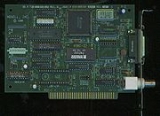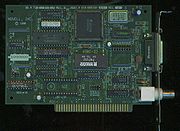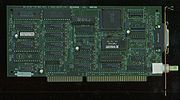
NE2000
Encyclopedia
The NE1000/NE2000 is an early line of low cost Ethernet
network card
s originally produced by Novell
. Its popularity had a significant impact on the pervasiveness of networks in computing. They are based on a National Semiconductor
prototype design using their 8390 Ethernet chip.


product into a PC-based server operating system that was agnostic and independent of the physical network implementation and topology
(Novell even referred to NetWare as a NOS, or "network operating system"). To do this, Novell needed networking technology in general — and networking cards in particular — to become a commodity, so that the server operating system and protocols would become the differentiating technology.
Most of the key pieces of this strategy were already in place: Ethernet and token ring (among others) had been codified by the IEEE 802 standards
committee — the draft was not formally adopted until 1990, but was already in widespread use, and cards from one vendor were, on the whole, wire-compatible with cards complying with the same 802 working group. However, networking hardware vendors in general, and industry leaders 3Com and IBM in particular, were charging high prices for their hardware.
To combat this, Novell decided to develop its own line of cards. In order to create these at minimal R&D
, engineering
and production
costs, Novell simply implemented, almost verbatim, a prototype design created by National Semiconductor
using the 8390 Ethernet chip. National Semiconductor, for its part, had no qualms about the use of the design; the use of National Semiconductor chips made the proposal almost pure profit. However, since the design had only been intended as a proof-of-concept prototype, it implemented bare-minimum functionality: PIO was used instead of DMA
, no buffering
was provided and no provision was made for the use of a transceiver
.
The original cards, the NE1000 (8-bit ISA
) and NE2000 (16-bit ISA), and the corresponding use of limited 8-bit and later 16-bit DMA in the NE2000 uses thin Ethernet
; the second ("B") revision added an Attachment Unit Interface
(AUI) port to support a transceiver, and later models NE1000T and NE2000T added built-in 10BASE-T
support. The "NE" prefix stood for "Novell Ethernet".
Novell released the cards through its Eagle subsidiary, and sold them for little to no profit. The cards were widely criticized for poor performance; but, for organizations rolling out NetWare LANs with hundreds or thousands of desktop nodes, the cost savings afforded by Novell's cards (they were as little as 25% of the cost of competitive cards), combined with guaranteed NetWare compatibility, made them an easy choice. Novell, for its part, made its profit from the sales of NetWare, which was licensed on a per-node, per-server model; thus, it could afford to sell the cards themselves at zero profit, knowing that every card sold virtually guaranteed a corresponding NetWare node license.
The success of the cards prompted the creation of a cottage industry of clone cards, which were compatible (to varying degrees) with Novell's cards. Novell eventually spun off the Eagle division as a separate company, Anthem Technologies, which was later bought by Artisoft, then sold to Microdyne. These companies continued to develop enhanced versions of the cards, producing versions with technology improvements (e.g. DMA/bus mastering, buffering), Plug and Play, and support for other network topologies (e.g. token ring, Fast Ethernet
) and bus architectures (e.g. EISA
, PCI
, PCMCIA
).
In order to remain competitive with Novell's bargain-price cards, 3Com
and other vendors were forced to cut the pricing of their entry-level network cards, contributing greatly to the networking boom of the 1990s. To a lesser extent, it is arguable that the success of the NE1000/2000 cards helped to tip the scale of the "LAN wars" in favor of Ethernet
(championed by 3Com) over token ring (championed by IBM
).
In 2003 National Semiconductor ceased manufacturing of the 8390 chip.
, Microsoft Windows
, UNIX
, FreeBSD
, QNX
, and Linux
. Note that Windows XP
does not support non-Plug and Play versions and Windows Vista
does not support the NE2000 at all. Windows 2000
appears to have a working driver.
Ethernet
Ethernet is a family of computer networking technologies for local area networks commercially introduced in 1980. Standardized in IEEE 802.3, Ethernet has largely replaced competing wired LAN technologies....
network card
Network card
A network interface controller is a computer hardware component that connects a computer to a computer network....
s originally produced by Novell
Novell
Novell, Inc. is a multinational software and services company. It is a wholly owned subsidiary of The Attachmate Group. It specializes in network operating systems, such as Novell NetWare; systems management solutions, such as Novell ZENworks; and collaboration solutions, such as Novell Groupwise...
. Its popularity had a significant impact on the pervasiveness of networks in computing. They are based on a National Semiconductor
National Semiconductor
National Semiconductor was an American semiconductor manufacturer, that specialized in analog devices and subsystems,formerly headquartered in Santa Clara, California, USA. The products of National Semiconductor included power management circuits, display drivers, audio and operational amplifiers,...
prototype design using their 8390 Ethernet chip.


History
In the late 1980s, Novell was looking to shed its hardware server business and transform its flagship NetWareNovell NetWare
NetWare is a network operating system developed by Novell, Inc. It initially used cooperative multitasking to run various services on a personal computer, with network protocols based on the archetypal Xerox Network Systems stack....
product into a PC-based server operating system that was agnostic and independent of the physical network implementation and topology
Network topology
Network topology is the layout pattern of interconnections of the various elements of a computer or biological network....
(Novell even referred to NetWare as a NOS, or "network operating system"). To do this, Novell needed networking technology in general — and networking cards in particular — to become a commodity, so that the server operating system and protocols would become the differentiating technology.
Most of the key pieces of this strategy were already in place: Ethernet and token ring (among others) had been codified by the IEEE 802 standards
IEEE 802
IEEE 802 refers to a family of IEEE standards dealing with local area networks and metropolitan area networks.More specifically, the IEEE 802 standards are restricted to networks carrying variable-size packets. IEEE 802 refers to a family of IEEE standards dealing with local area networks and...
committee — the draft was not formally adopted until 1990, but was already in widespread use, and cards from one vendor were, on the whole, wire-compatible with cards complying with the same 802 working group. However, networking hardware vendors in general, and industry leaders 3Com and IBM in particular, were charging high prices for their hardware.
To combat this, Novell decided to develop its own line of cards. In order to create these at minimal R&D
Research and development
The phrase research and development , according to the Organization for Economic Co-operation and Development, refers to "creative work undertaken on a systematic basis in order to increase the stock of knowledge, including knowledge of man, culture and society, and the use of this stock of...
, engineering
Electrical engineering
Electrical engineering is a field of engineering that generally deals with the study and application of electricity, electronics and electromagnetism. The field first became an identifiable occupation in the late nineteenth century after commercialization of the electric telegraph and electrical...
and production
Manufacturing
Manufacturing is the use of machines, tools and labor to produce goods for use or sale. The term may refer to a range of human activity, from handicraft to high tech, but is most commonly applied to industrial production, in which raw materials are transformed into finished goods on a large scale...
costs, Novell simply implemented, almost verbatim, a prototype design created by National Semiconductor
National Semiconductor
National Semiconductor was an American semiconductor manufacturer, that specialized in analog devices and subsystems,formerly headquartered in Santa Clara, California, USA. The products of National Semiconductor included power management circuits, display drivers, audio and operational amplifiers,...
using the 8390 Ethernet chip. National Semiconductor, for its part, had no qualms about the use of the design; the use of National Semiconductor chips made the proposal almost pure profit. However, since the design had only been intended as a proof-of-concept prototype, it implemented bare-minimum functionality: PIO was used instead of DMA
Direct memory access
Direct memory access is a feature of modern computers that allows certain hardware subsystems within the computer to access system memory independently of the central processing unit ....
, no buffering
Buffer (computer science)
In computer science, a buffer is a region of a physical memory storage used to temporarily hold data while it is being moved from one place to another. Typically, the data is stored in a buffer as it is retrieved from an input device or just before it is sent to an output device...
was provided and no provision was made for the use of a transceiver
Medium Attachment Unit
A Medium Attachment Unit is a transceiver which converts signals on an Ethernet cable to and from Attachment Unit Interface signals.On original 10BASE5 Ethernet, the MAU was typically clamped to the Ethernet cable...
.
The original cards, the NE1000 (8-bit ISA
Industry Standard Architecture
Industry Standard Architecture is a computer bus standard for IBM PC compatible computers introduced with the IBM Personal Computer to support its Intel 8088 microprocessor's 8-bit external data bus and extended to 16 bits for the IBM Personal Computer/AT's Intel 80286 processor...
) and NE2000 (16-bit ISA), and the corresponding use of limited 8-bit and later 16-bit DMA in the NE2000 uses thin Ethernet
10BASE2
10BASE2 is a variant of Ethernet that uses thin coaxial cable , terminated with BNC connectors...
; the second ("B") revision added an Attachment Unit Interface
Attachment Unit Interface
An Attachment Unit Interface is a 15 pin connection that provides a path between a node's Ethernet interface and the Medium Attachment Unit , sometimes known as a transceiver. It is the part of the IEEE Ethernet standard located between the Media Access Control , and the MAU...
(AUI) port to support a transceiver, and later models NE1000T and NE2000T added built-in 10BASE-T
Ethernet over twisted pair
Ethernet over twisted pair technologies use twisted-pair cables for the physical layer of an Ethernet computer network. Other Ethernet cable standards employ coaxial cable or optical fiber. Early versions developed in the 1980s included StarLAN followed by 10BASE-T. By the 1990s, fast, inexpensive...
support. The "NE" prefix stood for "Novell Ethernet".
Novell released the cards through its Eagle subsidiary, and sold them for little to no profit. The cards were widely criticized for poor performance; but, for organizations rolling out NetWare LANs with hundreds or thousands of desktop nodes, the cost savings afforded by Novell's cards (they were as little as 25% of the cost of competitive cards), combined with guaranteed NetWare compatibility, made them an easy choice. Novell, for its part, made its profit from the sales of NetWare, which was licensed on a per-node, per-server model; thus, it could afford to sell the cards themselves at zero profit, knowing that every card sold virtually guaranteed a corresponding NetWare node license.
The success of the cards prompted the creation of a cottage industry of clone cards, which were compatible (to varying degrees) with Novell's cards. Novell eventually spun off the Eagle division as a separate company, Anthem Technologies, which was later bought by Artisoft, then sold to Microdyne. These companies continued to develop enhanced versions of the cards, producing versions with technology improvements (e.g. DMA/bus mastering, buffering), Plug and Play, and support for other network topologies (e.g. token ring, Fast Ethernet
Fast Ethernet
In computer networking, Fast Ethernet is a collective term for a number of Ethernet standards that carry traffic at the nominal rate of 100 Mbit/s, against the original Ethernet speed of 10 Mbit/s. Of the fast Ethernet standards 100BASE-TX is by far the most common and is supported by the...
) and bus architectures (e.g. EISA
Extended Industry Standard Architecture
The Extended Industry Standard Architecture is a bus standard for IBM PC compatible computers...
, PCI
Peripheral Component Interconnect
Conventional PCI is a computer bus for attaching hardware devices in a computer...
, PCMCIA
PC Card
In computing, PC Card is the form factor of a peripheral interface designed for laptop computers. The PC Card standard was defined and developed by the Personal Computer Memory Card International Association which itself was created by a number of computer industry companies in the United States...
).
In order to remain competitive with Novell's bargain-price cards, 3Com
3Com
3Com was a pioneering digital electronics manufacturer best known for its computer network infrastructure products. The company was co-founded in 1979 by Robert Metcalfe, Howard Charney, Bruce Borden, and Greg Shaw...
and other vendors were forced to cut the pricing of their entry-level network cards, contributing greatly to the networking boom of the 1990s. To a lesser extent, it is arguable that the success of the NE1000/2000 cards helped to tip the scale of the "LAN wars" in favor of Ethernet
Ethernet
Ethernet is a family of computer networking technologies for local area networks commercially introduced in 1980. Standardized in IEEE 802.3, Ethernet has largely replaced competing wired LAN technologies....
(championed by 3Com) over token ring (championed by IBM
IBM
International Business Machines Corporation or IBM is an American multinational technology and consulting corporation headquartered in Armonk, New York, United States. IBM manufactures and sells computer hardware and software, and it offers infrastructure, hosting and consulting services in areas...
).
In 2003 National Semiconductor ceased manufacturing of the 8390 chip.
Clones
Many other manufacturers copied the design labeling under their own brand, while still claiming NE1000/NE2000 compatibility. However, in reality this was not always the case. For instance, the Winbond 83C901 ignores the reset signal.Supported operating systems
Besides NetWare, driver support for these cards was (and still is) available for a variety of operating systems, including DOSDOS
DOS, short for "Disk Operating System", is an acronym for several closely related operating systems that dominated the IBM PC compatible market between 1981 and 1995, or until about 2000 if one includes the partially DOS-based Microsoft Windows versions 95, 98, and Millennium Edition.Related...
, Microsoft Windows
Microsoft Windows
Microsoft Windows is a series of operating systems produced by Microsoft.Microsoft introduced an operating environment named Windows on November 20, 1985 as an add-on to MS-DOS in response to the growing interest in graphical user interfaces . Microsoft Windows came to dominate the world's personal...
, UNIX
Unix
Unix is a multitasking, multi-user computer operating system originally developed in 1969 by a group of AT&T employees at Bell Labs, including Ken Thompson, Dennis Ritchie, Brian Kernighan, Douglas McIlroy, and Joe Ossanna...
, FreeBSD
FreeBSD
FreeBSD is a free Unix-like operating system descended from AT&T UNIX via BSD UNIX. Although for legal reasons FreeBSD cannot be called “UNIX”, as the direct descendant of BSD UNIX , FreeBSD’s internals and system APIs are UNIX-compliant...
, QNX
QNX
QNX is a commercial Unix-like real-time operating system, aimed primarily at the embedded systems market. The product was originally developed by Canadian company, QNX Software Systems, which was later acquired by Canadian BlackBerry-producer Research In Motion.-Description:As a microkernel-based...
, and Linux
Linux
Linux is a Unix-like computer operating system assembled under the model of free and open source software development and distribution. The defining component of any Linux system is the Linux kernel, an operating system kernel first released October 5, 1991 by Linus Torvalds...
. Note that Windows XP
Windows XP
Windows XP is an operating system produced by Microsoft for use on personal computers, including home and business desktops, laptops and media centers. First released to computer manufacturers on August 24, 2001, it is the second most popular version of Windows, based on installed user base...
does not support non-Plug and Play versions and Windows Vista
Windows Vista
Windows Vista is an operating system released in several variations developed by Microsoft for use on personal computers, including home and business desktops, laptops, tablet PCs, and media center PCs...
does not support the NE2000 at all. Windows 2000
Windows 2000
Windows 2000 is a line of operating systems produced by Microsoft for use on personal computers, business desktops, laptops, and servers. Windows 2000 was released to manufacturing on 15 December 1999 and launched to retail on 17 February 2000. It is the successor to Windows NT 4.0, and is the...
appears to have a working driver.
External links
- DP8390D - NIC Network Interface Controller (Obsolete) (National Semiconductor) — original reference design
- Ne2000 (wiki.OSDev.org)

